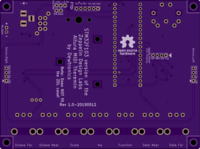MIDI Theremin using STM32F103C8T6 Blue Pill V1
author: dewhisna
2 layer board of 4.71 x 3.51 inches (119.5 x 89.0 mm)
Uploaded:
May 28, 2019
Shared:
July 09, 2019
Total Price:
$82.45
STM32F103C8T6 “Blue Pill” version of the Zeppelin Design Labs Altura MIDI Theremin.
Details on this remix, including source code, schematics, bill-of-materials, and 3D Printed case files, can be found on GitHub.
ERRATA: The MIDI Out DIN port incorrectly inverts the PA9 (USART Tx) output via Q1. This needs to be modified to either add a second inversion to the Q1 buffer logic to invert it back or to remove the Q1 buffer entirely, as the STM32 output can sink enough current. The simplest in-place fix is the latter, which can be implemented by removing Q1 and R3 and replace them with a LL4148 diode with the anode at pin 3 of the Q1 (i.e. its collector pin and connection point to R2) and the cathode at the PA9 end of R3. The reason for the diode is to make the STM32’s output only sink the MIDI pin to ground. This is needed because without it, the +3.3v output of the STM32 may be enough to turn on the MIDI receiver’s optoisolator since the other side of the MIDI connection is powered via +5v.
STM32F103C8T6 “Blue Pill” version of the Zeppelin Design Labs Altura MIDI Theremin.
Details on this remix, including source code, schematics, bill-of-materials, and 3D Printed case files, can be found on GitHub.
ERRATA: The MIDI Out DIN port incorrectly inverts the PA9 (USART Tx) output via Q1. This needs to be modified to either add a second inversion to the Q1 buffer logic to invert it back or to remove the Q1 buffer entirely, as the STM32 output can sink enough current. The simplest in-place fix is the latter, which can be implemented by removing Q1 and R3 and replace them with a LL4148 diode with the anode at pin 3 of the Q1 (i.e. its collector pin and connection point to R2) and the cathode at the PA9 end of R3. The reason for the diode is to make the STM32’s output only sink the MIDI pin to ground. This is needed because without it, the +3.3v output of the STM32 may be enough to turn on the MIDI receiver’s optoisolator since the other side of the MIDI connection is powered via +5v.

